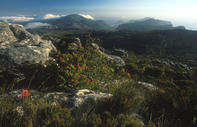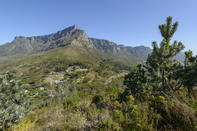Back Table
People who take the cable car up Table Mountain seldom get to see just how extensive the Back Table is. Indeed it is a veritable mountain wilderness within line of sight of the upper cable station, but you have to cross the upper Platteklip ravine to get there, so that usually sorts the mountain goats from the lounge lizards.

The whole mountain, in fact, is rift by a huge cleft on top, Disa Gorge. Between 1896 and 1907, five stone-wall dams — Woodhead, Hely-Hutchinson, De Villiers, Alexandria and Victoria — were built across the gorge to supply the city below with water. Today dams such as Steenbras, Voëlvlei, Theewaterskloof and Berg River supply most of the region's water, but the dams on top of the table are a wonderful addition to the city's attractions.
Table Mountain Caves
Not many people know that Table Mountain is a veritable Swiss cheese of small and large caves, although over the years many a curious schoolboy has had to be rescued from them. Some of the caves are mere overhangs, like Elephant's Eye, Woodstock and Peers caves. Others are passages and cracks up to a kilometre long.
The caves have formed in various ways: those in the upper Table Mountain sandstone mainly by mechanical faulting, and those in the underlying shales and granites mostly by undersea or other water erosion — often in already formed cracks. The first reports of caving on Table Mountain were written by JCW Moore, who was shown Muizenberg Cave by his father in 1890.
From the 1920s to 1950s, school teacher Johan Meyer explored some 80 caves above Kalk Bay and Muizenberg. He and his fellow cavers were known as The Moles. Numerous previously unknown cave-dwelling organisms have been found in these caves.
Sites to Discover
In ancient Greek writing, reference was made to a flat-topped mountain looking over a bay somewhere in the Southern Hemisphere that was a supposed paradise on earth. There are even references to an island in that bay. How many places can you think of that fit the description?
Nowadays Table Mountain is considered one of the mystical New Age centres of spirituality, and whole books have been written on the subject. Anyone who has explored the mountain will agree it gets to you in some mysterious way. Capetonians have a certain well-known 'thing' about their mountain, so maybe there's something in it. Apparently, there are many sacred sites up there to discover.
Cape Floral Region

Laid down as sea sand in the ancient Agulhas Sea, around 450 million years ago, compressed beneath kilometers of further sand and shale deposits, rent by heat and friction, buckled by continental warping, and then, finally, slowly distinctly ground down by water and gravity: the creation of the distinctly flat-topped Table Mountain was a massive feat of nature.
Although it’s impossible to say just how old it is, what we know with certainty is that for centuries — perhaps even millennia - it's been a geographical icon and a landmark for explorers. Table Mountain is jealousy loved by Capetonians who live around its edges; so much so that they are sometimes unwilling to show off its many splendours to others. It is also a National Heritage Site.
The focal point of the Table Mountain National Park is part of the Cape Floral Region World Heritage Site and just about the most awesome 'green lung' of any city in the world. It's hard not to love even looking beyond its comely shape.
Devil's Peak Quarry
Every city has got its secret spots where adventurous young people go, looking for relaxation and good fun. Cape Town has got more than its fair share. While most people automatically head for the beaches, or into the forests, the somewhat more intrepid prefer the elevated solitude of the mine quarry, located above Vredehoek.
On still summer evenings, as the lights of the City Bowl and the harbour start to twinkle, there's a detached serenity about the views from the quarry rim. To get to the swimming hole requires a slightly more exciting trip, but that route is for you to discover.